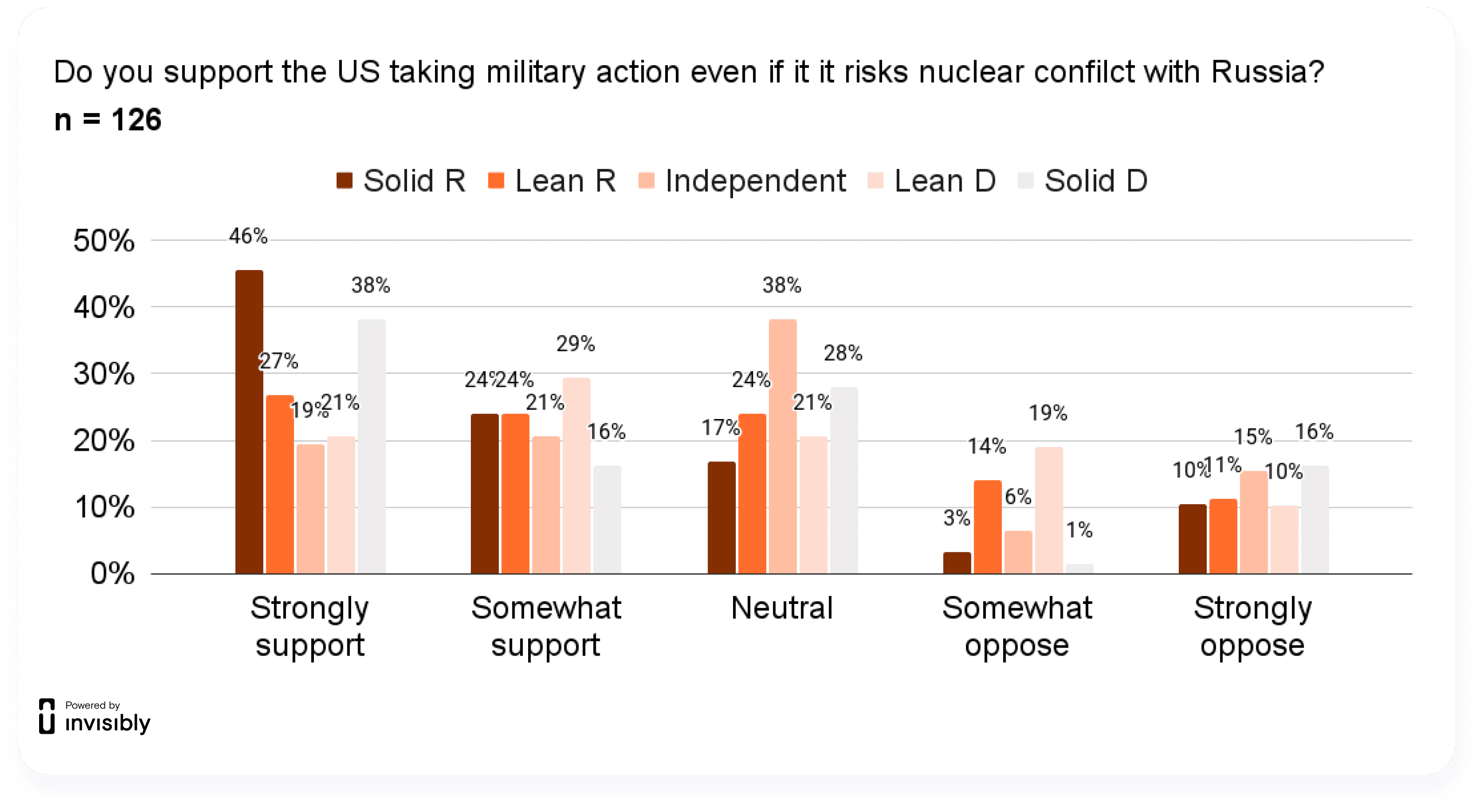Majority of Americans Think a Nuclear Conflict with Russia is Likely

According to a recent survey we conducted, many Americans think the current crisis in Ukraine will result in nuclear conflict. In fact, it has been over 70 years since the last use of nuclear weaponry in war. Our poll demonstrates that the majority of citizens are in favor of direct American military action even if that is the spark that leads to a nuclear conflict with Russia.
These findings are the result of an Invisibly poll of 600 Americans concerning the war in Ukraine. Invisibly used its Realtime Research product to record timely and accurate opinions on the war and potential U.S. responses.
Highlights
- Majority of respondents support taking military action even if it risks nuclear conflict with Russia.
- Majority of respondents believe the U.S. should institute a no-fly zone over Ukraine and maintain strict economic sanctions on Russia.
- Generally, most respondents feel that the U.S. is providing enough support to Ukraine and approve of President Biden’s response—although Democrats are more likely to say that more support can be given.
The Process
From March 24th to March 31st, we used a Realtime Research survey to canvas Americans about the war in Ukraine. We measured people’s thoughts about different aspects of the war including the U.S.’s response, maintaining sanctions on Russia, the likelihood of nuclear conflict, admission of refugees, and more.
We Asked
- Do you feel the US is doing enough to support Ukraine?
- Do you approve of President Biden’s response to Russia’s invasion of Ukraine?
- Do you think the US should institute a no-fly zone over Ukraine?
- How do you feel about keeping strict economic sanctions on Russia?
- How likely do you think a nuclear conflict with Russia is?
- Do you support the US taking military action even if it risks nuclear conflict with Russia?
- Do you support admitting Ukrainian refugees into the US?
 Figure 1. An example of the 300×250 Realtime Research survey unit.
Questions are shown to the user on web pages in place of an ad.
Figure 1. An example of the 300×250 Realtime Research survey unit.
Questions are shown to the user on web pages in place of an ad.
Invisibly Realtime Research differ from traditional online surveys in that the questions are shown to people on web pages in place of an ad (Figure 1), or to users on the Invisibly platform (Figure 2). Realtime Research surveys are optional, thus ensuring that participants are responding voluntarily.
Results
When it comes to the likelihood of nuclear warfare, the majority of respondents think nuclear warfare is very or somewhat likely. Additionally, the majority of respondents also support taking military action even if it risks nuclear warfare with Russia (Figure 2A, 2B). Breaking those respondents down by gender, the majority of men were supportive of taking military action while women were more likely to be neutral (Figure 2C). The majority of those who identified as Solid Republican and Solid Democrat said they support taking military action if it risks nuclear conflict with Russia while independents were more likely to be neutral (Figure 2D)



 Figure 2. Americans’ opinions on questions regarding nuclear war. A.
Majority of respondents think that nuclear war with Russia is likely or somewhat likely. B. Majority of all respondents support taking military action even if it risks nuclear conflict C. Men are more likely than women to support taking military action that risks nuclear conflict. D. Strong Republicans and Strong Democrats are more likely to strongly support taking military action that risks nuclear conflict while Independents are more
likely to remain neutral.
Figure 2. Americans’ opinions on questions regarding nuclear war. A.
Majority of respondents think that nuclear war with Russia is likely or somewhat likely. B. Majority of all respondents support taking military action even if it risks nuclear conflict C. Men are more likely than women to support taking military action that risks nuclear conflict. D. Strong Republicans and Strong Democrats are more likely to strongly support taking military action that risks nuclear conflict while Independents are more
likely to remain neutral.
The majority of all respondents think that the U.S. should Institute a no-fly zone over Ukraine and approve of keeping strict economic sanctions on Russia (Figure 3A, 3B).


Figure 3. Americans’ opinions regarding the implementation of a no-fly zone over Ukraine and maintaining economic sanctions on Russia. A. Majority of respondents support the implementation of a no-fly zone over Ukraine. B. Majority of all respondents strongly approve keeping strict economic sanctions on Russia.
Americans tend to agree on many of the questions posed relating to Ukraine— regardless of political affiliation. However, political party did indicate the strength of a respondents opinion in certain questions. For example, the majority of respondents agree that the U.S. is providing enough support (either the right amount or too much) to Ukraine and the majority of respondents also approve of President Biden’s Response (Figure 4A, 4B), but when we break down respondents by political affiliation, we see that the majority of those who identify as a Solid Republican feel that the U.S. is providing too much support while those who identify as an Independent or a Democrat are more likely to say that the U.S. is providing the right amount of support or not enough (Figure 4C). Women were also more likely than men to say that the U.S. is not providing enough support — although the majority of both men and women feel the U.S. is providing at least enough support (Figure 4D).



Figure 4. Americans’ opinions on the U.S. level of support for Ukraine and President Biden’s response. A. Majority of respondents feel that enough support has been provided to Ukraine by the U.S. but they differ on whether it is the right amount or too much. A significant number also feel there has not been enough support. B. Majority of all respondents strongly or somewhat approve of president Biden’s response to Russia’s invasion of Ukraine C. Majority of strong Republicans say that the Us has provided too much support while Democrats are more likely to say the U.S. has provided the right amount or not enough support to Ukraine D. Women are more likely than men to feel that the U.S. has not provided enough support to Ukraine.
Discussion
The most concerning point from the data above is that the majority of all respondents feel that nuclear conflict with Russia is very or somewhat likely. In our sample, the majority of respondents also support the U.S. implementing a no-fly zone over Ukraine — something that has been a contentious point of discussion as it has major implications — despite pleas from Ukraine’s President Zelenskyy for NATO to implement one.
If we dive further into the question of nuclear conflict, we discover a few interesting patterns based on demographics. First, it’s worth noting that women were more likely than men to say that the U.S. has not provided enough support to Ukraine and men were more likely than women to say that the U.S. has provided too much. While it appears that the male respondents in this survey are seemingly less sympathetic in regards to the level of support the U.S. should offer to Ukraine – they also demonstrate a more aggressive mindset towards taking military action at the risk of nuclear conflict with Russia. The majority of men strongly support or somewhat support taking military action even at the risk of nuclear conflict with Russia while women were more likely to be neutral in their feelings. Tangentially, strong Republicans and strong Democrats were the two most likely groups to strongly support taking military action at the risk of nuclear conflict with Russia.
This study shows interesting results with some more surprising than others. When the war in Ukraine began, we saw public officials in the U.S. across both sides of the aisle criticize Russia’s unprovoked attack on Ukraine and call for a plan — so it is not surprising to see that the majority of all respondents think that the U.S. has provided enough support to Ukraine and approve of President Biden’s plan. The only single political group in which a majority felt that the US provided too much support were those who identified as solid Republicans. All other groups were more likely to say the U.S. has provided the right amount or not enough support.
Invisibly Realtime Research surveys differ from traditional online surveys in that the questions are shown to the user on web pages in place of an ad. Unlike Google Surveys, which block access to content until the questions are answered, Realtime Research surveys are optional, thus ensuring that participants are responding voluntarily.

Invisibly
Use your data to access premium content you love.
